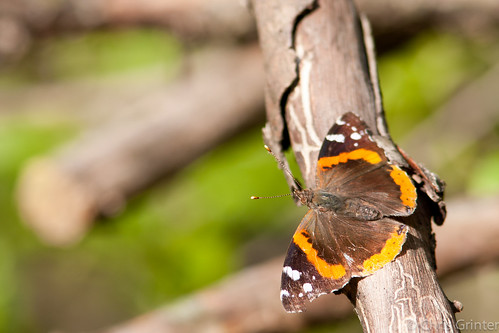די היגע נייַעס פֿאַר רובֿ פון די מזרח יו און קאַנאַדע האט שוין אַפלוטטער (האט) לעצטנס מיט ריפּאָרץ פון די יררופּטיאָן פון וואַנעססאַ אַטאַלאַנטאַ – די רויט אַדמיראַל באַבעלע. בשעת דעם איז אַ פּראָסט פּאַסירונג יעדער פרילינג פֿאַר די באַטערפלייז צו מייגרייט צפֿון פון זייער אָווערווינטערינג גראָונדס אין די דרום יו, די לויטער נומערן דעם יאָר זענען סטאַגערינג. עס זענען גאַנץ ממש טויזנטער פון אַדמיראַלס אין אונדזער צוריק יאַרדס.
אזוי וואָס ס פאַרשידענע דעם יאָר?
עס איז פיל ספּעקולאַציע וועגן דעם וואַרעם פרילינג וועטער (וואָרמאַסט מאַרץ אויף רעקאָרד פֿאַר פילע ערטער) און אָפֿט גורל פון מיסינפערמיישאַן צו גיין צוזאמען מיט עטלעכע פאָטעל ענטאָמאָלאָגי. רובֿ פון די נייַעס קוואלן איך ווע קומען אַריבער זאָגן די וואַרעם פרילינג האט ערלויבט די באַטערפלייז צו בליען און רעפּראָדוצירן אין אַבנאָרמאַל נומערן. אַז איז ניט גאַנץ מעגלעך אָבער, די. אַטאַלאַנטאַ overwinters as an adult. The southern states provide temps just warm enough for adult וואַנעססאַ butterflies to hide in the fall and be the very first to awaken in the spring to get a jump start on mating. אפילו אויב די באַטערפלייז זענען וואך אין פעברואר, די באַלעבאָס געוויקסן זענען נישט נאָך אַרויף (טיסאַלז); די באַטערפלייז אין אונדזער באַקיאַרד זענען פון לעצטע יאָר.
אָבער וואָס אויב וועטער האט פּלייַעד אַ ראָלע אין דעם בום ציקל? לעצטע יאָר איז געווען אַ לאַ נינאַ יאָר מיט אונדזער שיין און מילד ווינטער. א יאָר פריער איז געווען אַן El Niño, most of the eastern US was assaulted with winter and we suffered at the hands of the epic Chicago “snowpocalypse”. טאָמער די קאָמבינאַציע דיפּרעסט באַפעלקערונג איז גענוג 2010/2011 וואָס דעמאָלט דיקריסט פּאַראַסיטאָיד מאַסע, אַלאַוינג פֿאַר גרעסערע קוילעלדיק פלאַטערל פעקאַנדיטי אין די זומער פון 2011. די אָווערווינטערינג באַטערפלייז זענען דעמאָלט געגעבן אַ וואַרעם ווינטער אַז קען האָבן ערלויבט פֿאַר אַ נידעריקער ווינטער מאָרטאַליטי. ווי די באַטערפלייז אריבערגעפארן צפון דעם פרילינג עס זענען קיין פראָסטיק נעכט צו שנייַדן אין פּאַפּיאַליישאַנז – נאָר גורל פון הונגעריק פייגל. די רעזולטאַט וואָלט זיין אַ אַבנאָרמאַל ינפלאַקס פון מייגרייטינג באַטערפלייז.
אבער דעמאָלט ווידער…
Despite butterflies being so popular and well studied there doesn’t seem to be a perfect grip on what conditions each of the וואַנעססאַ species prefer. די וועריאַבאַלז פון באַלעבאָס געוויקסן, באַפעלקערונג קייט, וועטער און פּעראַסיטוידז אַלע שפּילן וויכטיק ראָלעס אין שעפע און פאַרשפּרייטונג. Did the weather cycles of the last few years variably effect one species over another? וואָס וויל אַז פד פּרויעקט (פון גיהנום)?
One of the best posts I’ve read is by Doug Taron over on גאַסאַמער טאַפּעסטרי – he is skeptical of this warm weather theory. Critically this irruption is effecting only the population of the Red Admiral and any theory involving weather would also likely effect other migrant butterflies like the Vanessa virginiensis – the American Lady. He also points out that an abundant butterfly like the admiral has classic cyclical population booms and busts in sync with parasite populations. I recall another summer in the late 90’s of staggering Admiral populations. Parasites really do better explain what we see in our yards this spring. While the weather might not have caused the abundance of די. אַטאַלאַנטאַ, there can be no denying that butterflies of all species have woken up much earlier this year.



As far as I recall, almost all temperate zone animals (and plants, איך כאָשעד) go thru boom and bust cycles. It’s pretty much the function/nature of the wildly variable environmental conditions of the ecosystems. Even the less common temperate zone species cycle but the effects are less noticed simply because of the lower population levels.
must have been a lovely sight, vanessa atlanta has been struggling in the UK for the past few years!!
A few years back you may have heard about the painted lady invasion in the UK very much the same as the USA i was counting well over 1000 an hour coming up the field from the english channel !
Quick question about la nina i believe the later part of 2010 was also la nina thats why the UK and northern USA had such cold weather